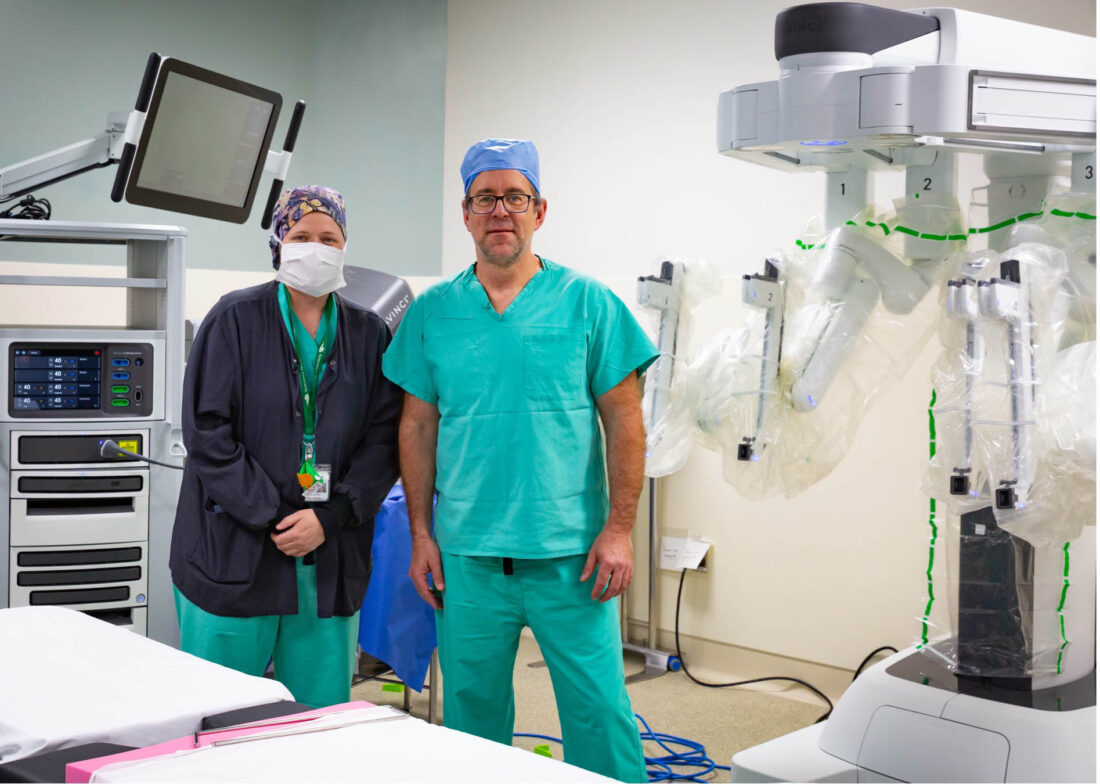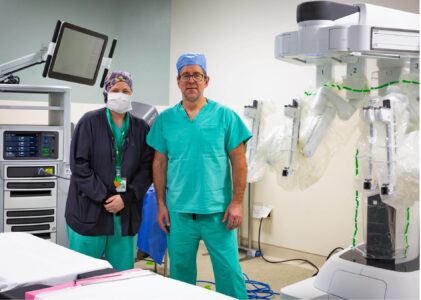Da Vinci surgical robot transforming laparoscopy at Adirondack Health

Urologist Dr. Jonathan Riddell and Clinical Leader Danielle Rootes are pictured with the da Vinci Surgical System in the operating room at Adirondack Medical Center in Saranac Lake. (Provided photo)
SARANAC LAKE — Adirondack Health has expanded its surgical capabilities with the acquisition of the state-of-the-art da Vinci Surgical System by Intuitive Surgical, bringing advanced, minimally invasive procedures to patients in the North Country.
Urologist Jonathan Riddell, M.D., FRCS, was a proponent of bringing the da Vinci to Adirondack Health. He has performed more than 400 pediatric and adult urology cases with the da Vinci robot system over the past decade. His first surgery with Adirondack Health’s da Vinci was conducted in January, and since then, several Adirondack Health surgeons — including Dr. Michael Hill and Dr. Emily Szczech — have utilized the da Vinci to perform their own surgeries.
“The da Vinci has transformed laparoscopy,” Dr. Riddell said. “This robotic platform allows you to perform very complex operations in a minimally invasive fashion — operations which previously required open surgery with large incisions.”
Dr. Riddell said when a surgeon uses a traditional laparoscopic instrument, they can insert it, move it left, right, up and down, and rotate it, providing four degrees of freedom. With the da Vinci, the instruments are wristed — a joint that mimics the human wrist, allowing the tool to move with greater precision and flexibility — giving surgeons seven degrees of freedom to manipulate and reconstruct tissue.
“With three small port site incisions, less than one centimeter, I’m able to look inside a patient and reconstruct a kidney or bladder, whereas before it would have otherwise been a large incision,” Dr. Riddell said. “So, patients can go home on the same day or next post-operative day but still benefit from the precision of an open reconstructive technique due to robotic visualization and control.”
By utilizing the da Vinci to perform these surgeries laparoscopically, Dr. Riddell said patients require much shorter hospital stays and experience less pain and less scarring.
The da Vinci consists of a surgeon’s console and a cart with several interactive robot arms controlled by the surgeon’s console. The robotic arms hold objects and can act as scalpels, scissors, cautery tools or graspers, while another arm controls the 3D cameras.
The surgeon uses the controls of the console to maneuver the cart’s robotic arms. The small, wristed instruments move like a human hand, but with an increased range of motion. It provides surgeons with a high-definition three-dimensional view of the surgical area, and the small instrument size allows them to operate through one of a few small incisions, so it’s much less invasive for patients.
The da Vinci robot’s arrival at Adirondack Health coincided with the arrival of another surgical robot — the Ion Robotic Bronchoscopy system. With the Ion, surgeons use a small scope to reach the farthest corners of the lungs to detect cancers in the earliest, most treatable stages. The procedure is also less invasive than a traditional bronchoscopy, so patients recover more quickly and can often return to their normal activities the next day. These advanced surgical robots help attract surgeons by offering them leading-edge technology.





